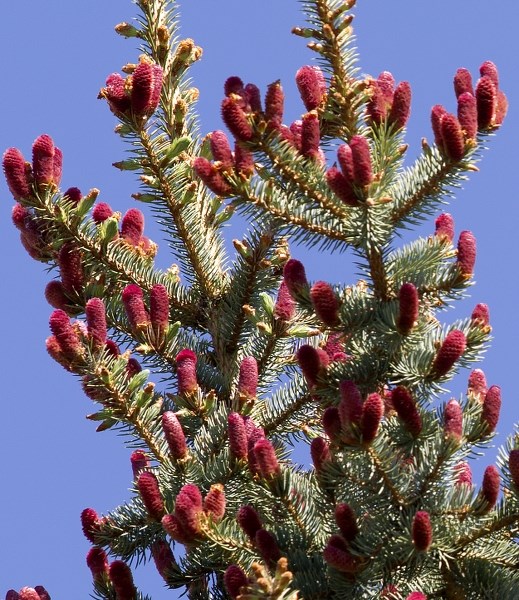St. Albert trees were doing their very best to be noticed this week. Excessive spruce-tree pollen drifted in clouds in the air and settled into a yellow scum on driveway puddles. Elm tree seeds were so numerous they piled up four or five inches deep in the gutters.
What the heck is happening with the trees? Is there more pollen than usual?
“I’ve never seen it like this, but then we had the longest winter I’ve ever seen too. Maybe it’s the winter,” surmised City of St. Albert Parks Foreman Kevin Veenstra.
Veenstra, an arborist, explained that for the most part the trees are doing what trees always do in June.
“Trees like white spruce, Colorado spruce and many conifers release their pollen now,” he said, pointing to a spruce tree that was releasing clouds of yellow dust.
The very tip top of the tree was covered with scarlet, cone-shaped flowers. From 30-feet below, it appeared as if the tree was blushing, while the rest of the spruce was covered with thousands of brown, pollen-laden nodules.
“These trees have both male and female parts. The red part is the female and the brown is the male. The dust storm of pollen being released these past few days, fertilizes the female flowers on top, and later in the summer, they become cones,” he said.
But environmental stresses, including lack of water in previous years, may be the cause for the extra pollen production now.
“Usually stress causes spruce to set more cones. The spruce must compete with turf grass for water. Though we had a lot of snow this year, over the last 10 years, the subterranean aquifers were at extreme lows and most of the water runs off in spring,” he said.
For homeowners, Veenstra said, the best thing to do is to pamper the trees in their yards and give them extra water.
Some species of deciduous trees, specifically anything in the plum family and even some elms didn’t lose their leaves last fall, setting up an odd pattern for this year’s first flush of leaves. The trees have both fresh green and old crumpled brown leaves on every branch.
“Some trees naturally hold their leaves, but last fall, I think the cold got in and hit them before they went dormant,” said Jim Hole of Hole’s Greenhouses and Gardens.
Most trees will continue to thrive but some trees could be in trouble.
In my own yard an Evans cherry tree still has last year’s leaves and in addition, it started the spring with sap oozing from cracks in the bark.
“That’s common for trees in the plum family such as Evans cherries,” Hole said, as he explained that if the sap didn’t go down the trunk in the fall, it could expand in the winter when the sun hit it, causing the bark to split.
“Even if it bloomed this year, you could still lose the tree because the bark is cracked and therefore the tree is more prone to injury,” Hole said.
If the Evans cherry tree survives, the best thing to do to protect it in future winters is to provide it with a screen to shade it from the winter sun.
“Don’t wrap it, but put something there to screen it so it is less affected by freezing and thawing,” Hole said.
Black Knot is a fungal disease that affects wile chokecherries, pin cherries and Mayday trees.
“It’s rampant throughout Alberta. It’s thought to have been brought into the province in the late 1980s on western chokecherries from the United States. But it was inevitable that it would spread here anyway because we have our own native chokecherries,” Veenstra said.
The fungus is ugly and looks like a swollen, tarry, black blob on tree branches. If it is left alone it will eventually kill the tree. The fungus also releases spores that infect other trees with the disease.
There is no cure but if the Black Knot is removed in the early stages, the tree may thrive.
“Prune off the infected part by pruning back to a lateral branch so the spores don’t affect the trunk of the tree. Make sure you disinfect your pruning sheers,” Veenstra said.
Hole noted that improper planting techniques also add to the stress of a tree. It’s critical that the space around the trunk of the tree be left bare or the tree will die.
“A lot of people put fabric around a tree, or rock, or bark. Nothing should touch the trunk of the tree. Ever! No rock, no bark, no fabric, no piled up soil! Nothing!” Hole said.
Trees need to be supported, but they shouldn’t be bound so tightly that they cannot sway with the wind and if you do tie them, make sure the bark is not cut in the process.
“Don’t over-stake the tree. People tie them up too tightly but trees have to move to get strong. They need to have room to move and if they need to be tied, use something soft to tie them up with. Don’t love the tree to death but it probably needs more water than you think,” Hole said.




